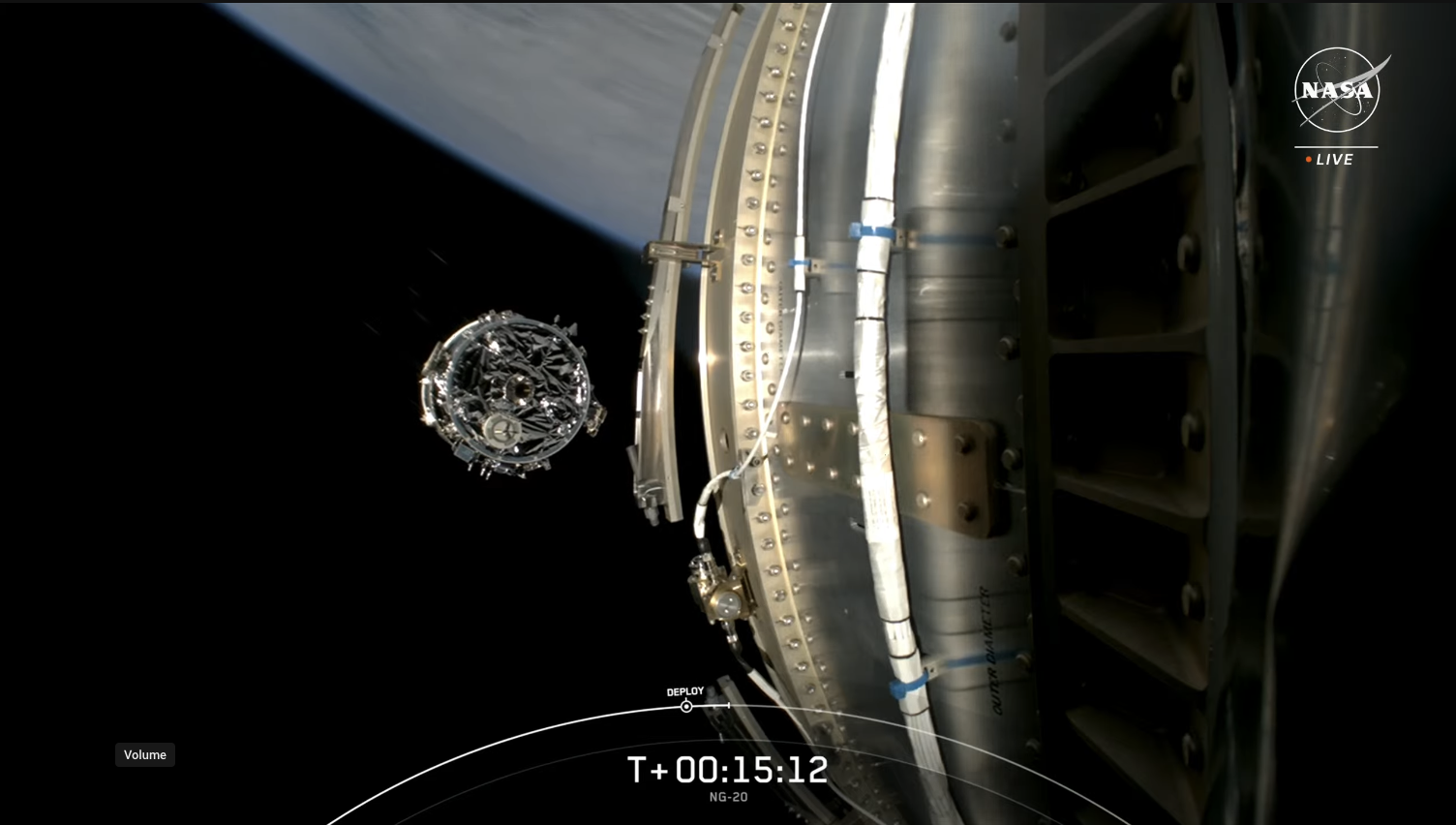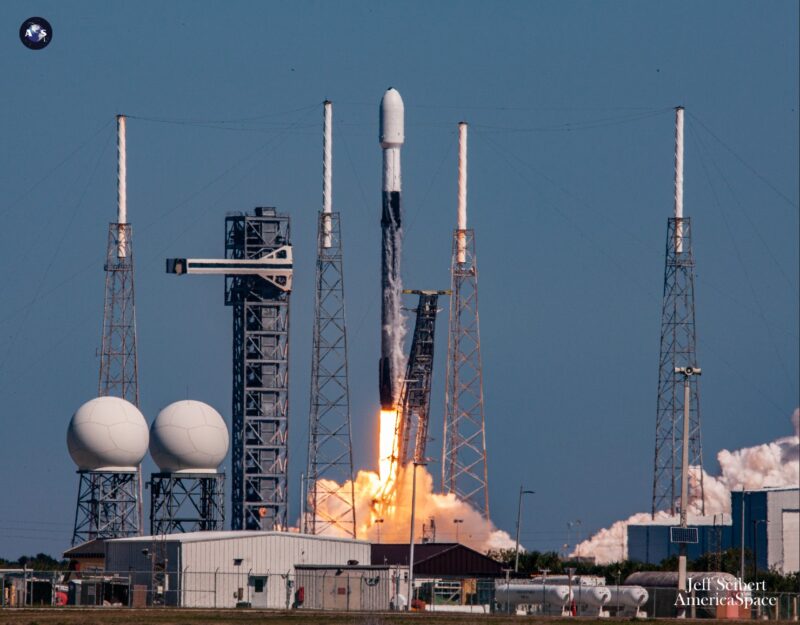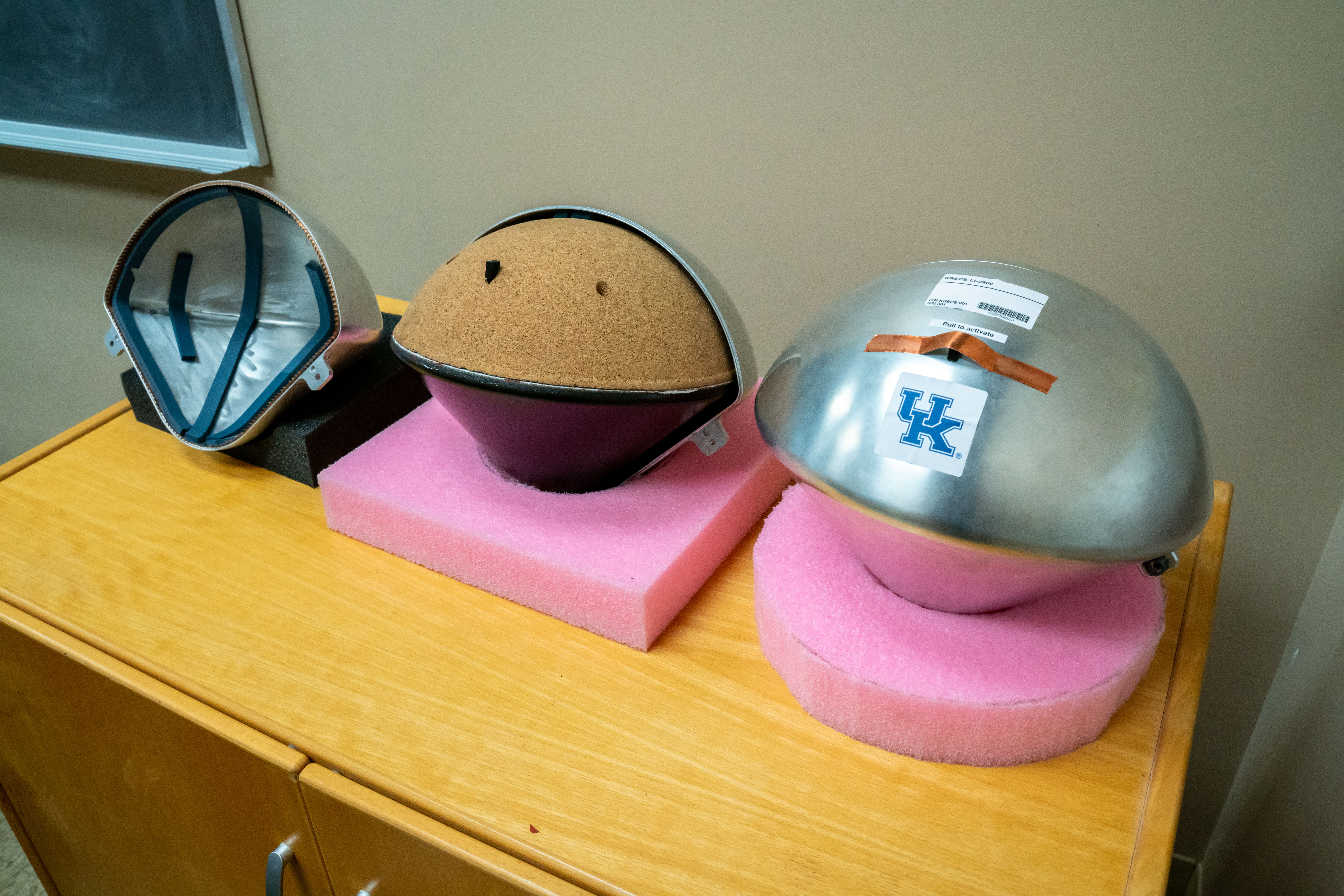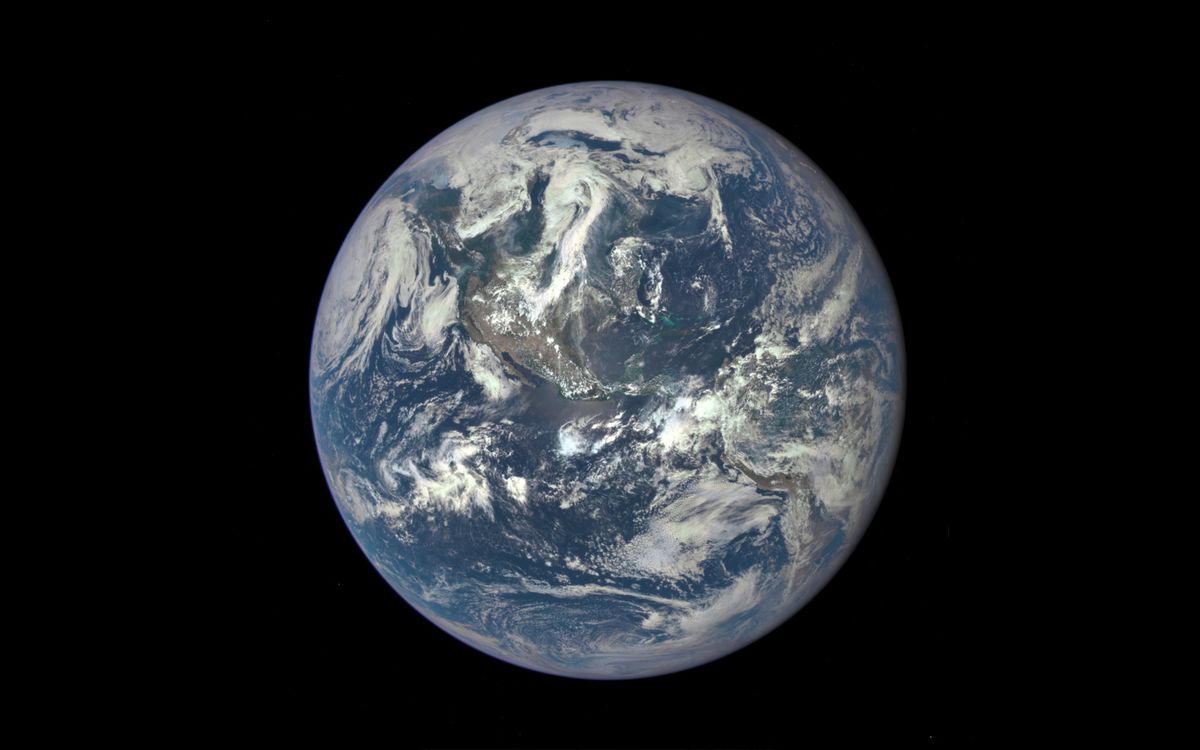
Following a back-to-back pair of post-sunset missions out of the East and West Coasts on Sunday evening, SpaceX on Tuesday wrapped up its first ten-launch month, its first four-launch Vandenberg month and the first Falcon 9 to carry a Northrop Grumman Corp. Cygnus cargo ship to the International Space Station (ISS). Veteran B1077—the 13th booster since May 2021 to reach a tenth flight—took flight from storied Space Launch Complex (SLC)-40 at Cape Canaveral Space Force Station, Fla., at 12:07 p.m. EST, carrying the NG-20 Cygnus and more than 8,200 pounds (3,700 kilograms) of equipment, payloads and supplies for the station’s incumbent Expedition 70 crew.


Photo credit: Jeff Seibert/AmericaSpace


In doing so, B1077 completed her tenth launch in under 16 months, a rapid cadence surpassed by only two other boosters, notably frequent flyer B1076 which reached her own No. 10 earlier this month only 403 days after her maiden flight. For her own part, since October 2022 B1077 has lofted more than a hundred Starlink low-orbiting internet communications satellites, crewed and uncrewed missions to the ISS, a pair of geostationary communications satellites and the latest Block III Global Positioning System (GPS) navigation and timing satellite on behalf of the U.S. Space Force.
In flying SpaceX’s first Cygnus, B1077 becomes the first Falcon 9 booster to launch cargo missions for both of NASA’s in-service Commercial Resupply Services (CRS) partners, having also launched a Cargo Dragon to the space station in June 2023. Her Cygnus duty came about in the months preceding last August’s retirement of Northrop Grumman’s home-grown Antares 230+ rocket, leaving a gap in capability of up to two years before the next-generation 300-series iteration comes online with Firefly Aerospace-furnished Miranda engines sometime after mid-2025.


In response to this gap, in August 2022 Northrop Grumman contracted with SpaceX to fly three Cygnuses—NG-20, NG-21 and NG-22—before the first 300-series Antares enters service to launch NG-23 and beyond. In readiness for the mission, the Pressurized Cargo Module (PCM) was transported overland from Northrop Grumman’s Dulles, Va., facility to the Space Coast last summer, followed by the Service Module (SM) from Thales Alenia Space’s site in Turin, Italy, in mid-December; the pair were subsequently mated and loading of Cygnus with early cargo commenced on 14 January.
The complete spacecraft, which stands 21 feet (6.4 meters) tall and boasts an internal pressurized volume of 950 cubic feet (27 cubic meters), was moved to SLC-40 on 25 January for encapsulation inside the Falcon 9 payload fairing and stacking atop the booster. In comments provided at last week’s NG-20 Prelaunch Media Teleconference, Bill Gerstenmaier—a former senior NASA leader who now serves as SpaceX’s vice president of build and flight reliability—noted that a small, environmentally-controlled “door” had to be added to the fairing to permit technicians to access Cygnus for the late-loading of time-critical cargo items on Monday afternoon/evening.


According to Mr. Gerstenmaier, this door measures approximately five feet (1.5 meters) by four feet (1.2 meters) and facilitates the process, ensuring clean-room-like levels of environmental stability. Noting that adding a door into Falcon 9’s fairing for such a purpose marked “the first time we’ve done that”, he explained that the front end of Cygnus which attaches to the ISS is particularly sensitive, with berthing rings in particular requiring extreme levels of cleanliness and lack of contaminants.
Preparations for NG-20 have been ongoing in orbit, aboard the station itself, where Expedition 70’s Jasmin Moghbeli and Loral O’Hara will be on duty in the multi-windowed cupola early Thursday for the cargo ship’s arrival. On Monday, the two astronauts practiced their responsibilities on laptop computers, with Moghbeli expected to grapple Cygnus using the station’s 57.7-foot-long (17.6-meter) Canadarm2 at about 4:15 a.m. EST as O’Hara monitors the rendezvous and capture.


Delayed from its original 12:29 p.m. EST Monday launch date due to the fairing door and late-load activities at the pad, NG-20 targeted an “instantaneous” T-0 at 12:07 p.m. EST Tuesday. Weather conditions were predicted to be around 95-percent-favorable, dipping slightly to 90 percent for a 48-hour turnaround to 11:18 a.m. EST Thursday.
“Expect a crisp start to the day on Tuesday with temperatures in the 40s on the Spaceport,” noted the 45th Weather Squadron at Patrick Space Force Base in its L-1 update, issued on Monday. “Cloud cover is expected to remain mostly offshore over the warmer water, but some may creep in off the Atlantic.” A violation of the Cumulus Cloud Rule stood as Tuesday’s sole potential showstopper.


B1077 rose on time at 12:07 p.m. EST to complete SpaceX’s first ten-launch month, her nine Merlin 1D+ engines powering the 230-foot-tall (70-meter) stack aloft under 1.5 million pounds (680,000 kilograms) of thrust. The core stage separated at 2.5 minutes into ascent and returned to a smooth touchdown at the Cape’s Landing Zone (LZ)-1, marking the third “land” landing of January.
Meanwhile, the single Merlin 1D+ Vacuum engine of the Falcon 9’s second stage ignited for a six-minute firing to deliver the NG-20 Cygnus into orbit. The cargo ship and the booster parted company on time a little past 14 minutes and 40 seconds into the mission, with Cygnus now having deployed its fan-shaped solar arrays and on course for a 40-hour, 27-orbit rendezvous and orbit-phasing profile to reach the ISS early Thursday.


In keeping with tradition, NG-20 is named in honor of NASA astronaut, physician, flight instructor and space medicine fellow Dr. Patricia “Patty” Hilliard-Robertson (1963-2001). The ship carries more than 8,200 pounds (3,700 kilograms) of equipment, payloads and supplies for the station, including 2,490 pounds (1,129 kilograms) of crew supplies, 3,017 pounds (1,369 kilograms) of scientific investigations, 35 pounds (16 kilograms) of Extravehicular Activity (EVA) equipment, 2,493 pounds (1,131 kilograms) of vehicle hardware and 149 pounds (67 kilograms) of computer resources.
That brings to more than 146,000 pounds (66,000 kilograms) the total amount of cargo trucked uphill to the station on 20 missions since September 2013. Cygnus is also the only U.S. cargo vehicle in service with the capability to reboost the ISS orbit, having done so most recently last 11 August, when her engines raised the station’s altitude by 0.3 miles (0.5 kilometers) to a new apogee of 262 miles (422 kilometers) in readiness for future crew departures and arrivals.
Among NG-20’s haul of payloads is the Robotic Surgery Tech Demo, led by Principal Investigator Scott Tarry of the University of Nebraska at Omaha, which is capable of being remotely controlled or teleoperated from the ground. To be mounted in an Express rack locker aboard the ISS, this miniature surgical robot will conduct simulated surgical tasks to assess the effects of microgravity and time-lag latency upon its activities.
The robot will execute an autonomous subset of surgical tasks independently and a remotely teleoperated mode which will see it controlled by a user from an Earth-based interface. “As longer space missions become more common, the potential need for emergency care increased, including surgical procedures from simple stitching of lacerations to more complex activities,” NASA explained. “Results from this investigation could support development of robotic systems to perform procedures, ensuring the safety of crew members and the success of future missions.”


The Compartment Cartilage Tissue Construct investigation, led by Principal Investigator Yupeng Chen of the University of Connecticut, will demonstrate a pair of technologies—Janus Base Nanomatrix (JBNm) and Janus Base Nanopiece (JBNp)—to grow cartilage tissues in space with the intention of studying cartilage diseases and potential therapies to combat cartilage degenerative diseases, notably osteoarthritis.
The Kentucky Re-entry Probe Experiment (KREPE)-2 will see three instrumented capsules deployed inside Cygnus at the end of the NG-20 mission to evaluate affordable re-entry technologies. The capsules are outfitted with data-gathering sensors, including thermocouples positioned at various depths within their heat shields, to assess the thermal response during re-entry and transmit directly to orbiting Iridium satellites and from thence to ground stations.


Shortly before Cygnus departs the ISS in July, station crew members will remove the capsules, position them in three discrete locations and transition them into a “dormant” state as the cargo ship is loaded with waste materials for disposal. During re-entry, the KREPE-2 capsules will monitor Cygnus’ breakup in the upper atmosphere—evidenced by a temperature “spike” from on-board thermocouples, a specified level of acceleration, a physical detachment from the protective shell or a combination of all three—and continue recording until splashdown in the ocean is detected.
Manufacturing of Semiconductors and Thin-film Integrated Coatings (MSTIC), supplied by Made in Space of Jacksonville, Fla., will seek to produce high-quality, low-cost semiconductor chips for conceptual applications in the electronics industry. “The potential for producing films with superior surface structures and the broad range of applications from energy harvesting to advanced sensor technology are particularly groundbreaking,” said Alex Hayes of Redwire Space, which developed the technology. “This represents a significant leap in space manufacturing and could herald a new era of technological advancements with wide-reaching implications for both space exploration and terrestrial applications.”


Hewlett Packard Enterprise (HPE) will also fly an upgraded version of its Spaceborne Computer-2 (SBC-2) to build upon the accomplishments of two prior incarnations of this commercial, off-the-shelf supercomputing device. An initial test was conducted by SPC-1, which flew to the ISS aboard SpaceX’s CRS-12 Cargo Dragon in August 2017 and returned to Earth aboard CRS-17 in June 2019, logging 656 days aboard the station.
Initially targeted to spend a year on the ISS, the computer’s stay-time was extended an additional eight months and its work supporting ongoing station research, astronaut health monitoring and the processing of Earth observations. SBC-1 achieved a significant milestone when it ran one teraflop—equal to one trillion calculations per second—for the first time in space and by the time of its return home it had flawlessly executed 53,936 runs during 9,562 Earth orbits and 6,879 crossings of the high-radiation South Atlantic Anomaly (SAA).


The upgraded SBC-2 flew for the first time between February 2021 and January of last year, spending 686 days aboard the space station. For the first time, it took full advantage of on-board artificial intelligence and high-performing computing capabilities and trialed functionalities to recover and mitigate transient memory defects and errors.
“The Spaceborne Computer has the potential to not only accelerate data processing in space, but also speed up the exchange of data insights between Earth and space,” said Principal Investigator Mark Fernandez. Equipped with highly radiation-tolerant flight software, for its third mission the supercomputer features KIOXIA flash-memory storage to test storage and recovery on long-term future missions.


And the European Space Agency (ESA) is providing its 3D Metal Printer to test additive manufacturing or 3D-printing or small metallic components to examine their functionality, performance and operations, as well as their quality, strength and characteristics. Three-dimensional printing carries great potential for creating parts for maintaining equipment on future long-duration missions or deep-space expeditions to the Moon and Mars.
Also aboard NG-20 are a replacement hydrogen dome assembly for the ISS Oxygen Generation Assembly (OGA), a cylinder flywheel for the Advanced Resistive Exercise Device (ARED), new control and pump hardware for the Urine Processor Assembly (UPA) and a modification kit for the next set of Boeing-built ISS Roll-Out Solar Arrays (iROSAs). And crew favorites including hazelnut spread, coffee, houmous, ice cream and chocolate chip cookies are waiting inside the cargo ship to be found by Expedition 70.
FOLLOW AmericaSpace on Facebook and X!
Missions » ISS » COTS » CYGNUS »
Posts associated with the ISS missions
Posts associated with the COTS missions







